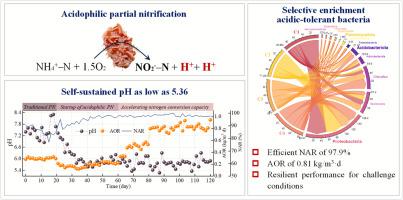当前位置:
X-MOL 学术
›
Water Res.
›
论文详情
Our official English website, www.x-mol.net, welcomes your feedback! (Note: you will need to create a separate account there.)
Acidophilic partial nitrification (pH<6) facilitates ultra-efficient short-flow nitrogen transformation: Experimental validation and genomic insights
Water Research ( IF 11.4 ) Pub Date : 2024-06-12 , DOI: 10.1016/j.watres.2024.121921 Fangzhai Zhang 1 , Ziyi Du 1 , Jiahui Wang 1 , Yujia Du 1 , Yongzhen Peng 1
Water Research ( IF 11.4 ) Pub Date : 2024-06-12 , DOI: 10.1016/j.watres.2024.121921 Fangzhai Zhang 1 , Ziyi Du 1 , Jiahui Wang 1 , Yujia Du 1 , Yongzhen Peng 1
Affiliation

|
Partial nitrification (PN) represents an energy-efficient bioprocess; however, it often confronts challenges such as unstable nitrite accumulation, nitrite oxidizing bacteria shocks, and slow reaction rate. This study established an acidophilic PN with self-sustained pH as low as 5.36. Over 120-day monitoring, nitrite accumulation rate (NAR) was stabilized at more than 97.9 %, and an ultra-high ammonia oxidation rate of 0.81 kg/m·d was achieved. Notably, least NAR of 77.8 % persisted even under accidental nitrite oxidizing bacteria invasion, aeration delay, alkalinity fluctuations, and cooling shocks. During processing, despite detrimental effects on bacterial diversity, there was a discernible increase in acid-tolerant bacteria responsible for nitrification. , gradually dominated in nitrifying guild (2.15 %), with the substantially reduction or disappearance of typical nitrifying microorganisms. , a key player in nitrogen cycling of soil, significantly increased from 0.45 % to 9.98 %, and its associated nitrogen metabolism genes showed a substantial 215 % rise. emerged as the most critical functional gene influencing acidophilic PN, exhibiting significantly higher unit gene expression than other nitrification genes. Blockade tricarboxylic acid cycle, DNA damage, and presence of free nitrous acid exert substantial effects on nitrite-oxidizing bacteria (NOB), serving as internal driving forces for acidophilic PN. This highlights the reliable potential for shortening nitrogen transformation process.
中文翻译:

嗜酸性部分硝化(pH<6)促进超高效短流氮转化:实验验证和基因组见解
部分硝化(PN)代表一种节能的生物过程;但常常面临亚硝酸盐积累不稳定、亚硝酸盐氧化菌冲击、反应速度慢等挑战。本研究建立了一种嗜酸 PN,其自维持 pH 值低至 5.36。经过120多天的监测,亚硝酸盐积累率(NAR)稳定在97.9%以上,实现了0.81 kg/m·d的超高氨氧化率。值得注意的是,即使在亚硝酸盐氧化细菌意外入侵、曝气延迟、碱度波动和冷却冲击的情况下,NAR 仍保持在 77.8% 的最低水平。在加工过程中,尽管对细菌多样性产生不利影响,但负责硝化作用的耐酸细菌明显增加。 ,逐渐在硝化群中占据主导地位(2.15%),典型硝化微生物大幅减少或消失。土壤氮循环的关键参与者,从0.45%显着增加到9.98%,其相关的氮代谢基因也大幅增加了215%。成为影响嗜酸 PN 的最关键的功能基因,其单位基因表达量显着高于其他硝化基因。三羧酸循环阻断、DNA 损伤和游离亚硝酸的存在对亚硝酸氧化细菌 (NOB) 产生重大影响,成为嗜酸 PN 的内部驱动力。这凸显了缩短氮转化过程的可靠潜力。
更新日期:2024-06-12
中文翻译:

嗜酸性部分硝化(pH<6)促进超高效短流氮转化:实验验证和基因组见解
部分硝化(PN)代表一种节能的生物过程;但常常面临亚硝酸盐积累不稳定、亚硝酸盐氧化菌冲击、反应速度慢等挑战。本研究建立了一种嗜酸 PN,其自维持 pH 值低至 5.36。经过120多天的监测,亚硝酸盐积累率(NAR)稳定在97.9%以上,实现了0.81 kg/m·d的超高氨氧化率。值得注意的是,即使在亚硝酸盐氧化细菌意外入侵、曝气延迟、碱度波动和冷却冲击的情况下,NAR 仍保持在 77.8% 的最低水平。在加工过程中,尽管对细菌多样性产生不利影响,但负责硝化作用的耐酸细菌明显增加。 ,逐渐在硝化群中占据主导地位(2.15%),典型硝化微生物大幅减少或消失。土壤氮循环的关键参与者,从0.45%显着增加到9.98%,其相关的氮代谢基因也大幅增加了215%。成为影响嗜酸 PN 的最关键的功能基因,其单位基因表达量显着高于其他硝化基因。三羧酸循环阻断、DNA 损伤和游离亚硝酸的存在对亚硝酸氧化细菌 (NOB) 产生重大影响,成为嗜酸 PN 的内部驱动力。这凸显了缩短氮转化过程的可靠潜力。
















































 京公网安备 11010802027423号
京公网安备 11010802027423号